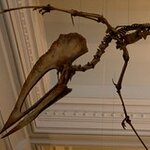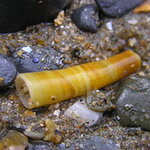Paleontology

A new analysis of the remains of a Tyrannosaurus rex (T. rex) that roamed Earth 68 million years ago has confirmed traces of protein from blood and bone, tendons, or cartilage.
The findings published in the Journal of Proteome Research is the latest dataset in an ongoing controversy over which biochemical remnants can be detected in the dino.
In the study, Marshall Bern, Brett S. Phinney and David Goldberg point out that the first analysis in 2007 (see Did Dinosaurs Become Chickens?) of a well-preserved, fossilized T. rex bone identified traces of seven distinct protein fragments, or…

Pterosaurs, the mighty winged-lizards, soared ancient skies expertly hunting for prey. Because they evolved from reptiles prior to modern birds, it was once believed that pterosaurs were primitive, passive fliers. They were seen as gliders, rather than skillfull hunters.Being the earliest vertebrates to have evolved powered flight, we now recognize that they were powerful fliers, chasing and catching their prey on the wing. One clue to this revelation is a small bone at the front of the wing bone which curves back towards the shoulder, roughly like an elongated thumb on a spread…

Researchers have already reconstructed fragments of genetic recipes for extinct animals such as the cave bear, the woolly mammoth and most recently, the moa, a giant bird that was at the top of New Zealand’s food chain until 700 years ago, shortly after the arrival of the Maori. Last year, scientists at the Max Planck Institute for Evolutionary Anthropology sequenced the complete mitochondrial genome of a Neanderthal that died 38,000 years ago. The mitochondria are the cell's powerhouses that have their own sets of genes. Those sequences were derived from tissue, bone and feathers that were…

Plant fossils from the Okanagan highlands, an area centred in the Interior of British Columbia, provide important clues to an ancient climate.While the area is referred to as the Okanagan, the term is used in a slightly misleading fashion to describe an arc of Eocene lakebed sites that extend from Smithers in the north, down to the fossil site of Republic Washington. The grouping includes the fossil sites of Driftwood Canyon, Quilchena, Allenby, Tranquille, McAbee, Princeton and Republic.These fossil sites range in time from Early to Middle Eocene, and the fossil they…

Hornby, one of the northern Gulf Islands on the west coast of British Columbia, has some of the best preserved fossil specimens of the Pacific Northwest. Many species of ammonites, bivalves and their marine compatriots can be found in the Upper Cretaceous shales and concretions of the Lambert Formation.
Interestingly, they are remarkably similar to the ones you find in the French and Tamil areas of Pondicherry, India, their presence providing a window back into the Maastrichtian some 70-million years ago.

L.A. paleontologists are heading to the mall but shopping is not top of mind. Zed, a nearly complete pleistocene mammoth has been unearthed by scientists from the George C. Page Museum from fossil rich deposits in an ancient river bed below the old May Co parking lot in the upscale Miracle Mile shopping district. The massive mammoth is 80% complete and sports tusks 10-feet long.
The find has the city of angels excited as it appears to be one of the richest fossil deposits of late ice age remains. Plans are to showcase Zed to the public along with one of the most complete displays of ice…

The fossil exposures of the Lincoln Creek Formation, southern Olympic Peninsula, near the town of Porter, Washington, 46°56'20"N, 123°18'38"W, consist of tuffaceous siltstone and sandstone with concretionary beds throughout. They are slightly older than originally thought, coming in around 37 million-years, straddling the Eocene-Oligocene border. The site has produced several dozen different species of molluscs, including the elusive tusk shell, and is well known for crabs.
Here a wee modern tusk shell or scaphopod sits in the sand. The whitish…

It is pretty safe to say that if the world of the dinosaurs were played out in the school yard, Pachycephalkosaurus, would definitely have been at the lowest end of the pecking order.

Until recently, elasmosaurs had never before been found in British Columbia. Nor had any other aquatic plesiosaurs, though similar creatures had been found on the coast of California and in the centre of North America, where once a central seaway split the continent. Elasmosaurs swam the seas for over 130 million years, feeding on the plentiful fish and shellfish.
Gastroliths – round, polished stomach stones – have been found amid their bones. These stones would have been swallowed to help grind down their catch and lower their natural buoyancy. In their selection of these pebbles,…

The mystery of the landlocked salmon in the fossil record from the Interior of British Columbia has been a topic of hot debate for a number of years. Salmon have permeated First Nations mythology and have been prized as an important food source for thousands of years. In the Interior of British Columbia, archaeological evidence dates the use of salmon as a food source back 3,500 years. Sheri Burton and Catherine Carlson were able to isolate and amplify mitochondrial DNA from salmon remains from archaeological sites near Kamloops, and identified the species as Oncorhynchus nerka, or Sockeye…